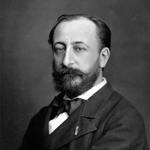SAINT-SAËNS
Notes on the composers and the pieces
Sergei Prokofiev
Symphony No. 1 “Classical”
Piotr Tchaikovsky
Symphony No. 6 “Pathétique”
Return to Home Page |

Camille Saint-Saëns: Piano Concerto No. 2 in G Minor
Camille Saint-Saëns was born in Paris on October 9, 1835. His father died soon after, and so he was raised by his mother and her aunt, who gave the boy piano lessons. He wrote his first piece at age four, accompanied a Beethoven violin sonata at five, and at seven, studied composition with Pierre Maleden and piano with Camille-Marie Stamaty. At ten, he played a recital in Paris that included concertos by Beethoven and Mozart and an encore offer to play any Beethoven sonata from memory. Enrolling at the Paris Conservatory at thirteen, he studied organ with François Benoist and composition with Fromental Halévy. His Symphony in A was completed in 1850 and the first of three numbered symphonies in 1853. There followed his Piano Quintet, Symphony Urbs Roma (both 1856), Piano Concerto No. 1 (1858), and Symphony No. 2 (1859).
From 1861 to 1865, Saint-Saëns was professor of piano at the École Niedermeyer. One of his students, Gabriel Fauré, eventually became his best friend. He also served as organist in several churches, including the Madeleine (1857 to 1877), where Liszt heard him and pronounced him the greatest organist in the world. He enjoyed enough success as a performer and composer for Napoleon III to keep him out of the Franco-Prussian War, though the Paris Commune drove him to London for a few months. He was versed in and wrote widely on the natural sciences, mathematics, archeology, geology, literature, philosophy, and history. He was also a poet and a playwright.
The young Saint-Saëns was an adventurous advocate of Schumann and a friend and supporter of Berlioz, who famously quipped of Saint-Saëns: “He knows everything, but lacks inexperience.” He also introduced Liszt, Bach, Mozart, and Handel to the French and promoted new music by French composers through the Societé Nationale de Musique. He defended Wagner against critics, and his performances of that composer’s scores prompted Hans von Bülow to call him “the greatest musical mind” of his era.
The composer married at age forty. Both his children died, one after a fall from a building. He blamed that on his wife”s negligence, walked out, and never saw her again. He became somewhat of a recluse thereafter, attaching himself to Fauré’s family. His mother’s death set him to traveling through Europe, North Africa, Southeast Asia, and South America. He also became increasingly conservative in his musical tastes, attacking Wagner, Debussy, Franck, d’Indy and other young composers, to the point where d’Indy moved to have him expelled from the Societé.
Saint-Saëns’s music displays clean textures and classical structures, which has earned him the nickname, the French Mendelssohn (though Gounod referred to him as the French Beethoven). His huge output includes symphonies, operas, orchestral and incidental pieces, works for organ, piano, and voice, plus, masses and sacred works. His major works appeared toward the late middle of his career: Danse Macabre (1872), Samson et Dalila (1877), the Organ Symphony and Carnival of the Animals (both 1886), Introduction and Rondo Capriccioso (1863), several tone poems, and others.
Saint-Saëns wrote his Second Piano Concerto in G Minor in 1868 to fill Anton Rubinstein’s request for a performance in Paris. Rubinstein conducted; Saint-Saëns was the soloist. It was his first major work, though its reception was indifferent: “from Bach to Offenbach,” one critic called it.
All movements are in sonata form. The first opens with a piano cadenza in the style of a Bach fantasia. The idea for the florid first theme in the piano over a barcarolle rhythm was Fauré’s. The second theme sounds in the piano over syncopation. The complex development leads to two cadenzas, one reprising the opening, plus a return of the main themes. The music become contemplative before a stern Beethoven-like ending.
The themes of the second movement, Allegro scherzando, are a perky Mendelssohnian idea and a lyrical tune that anticipates “Elephant” from Carnival of the Animals.
The Presto begins as a wild tarantella. The second theme is in delineated octaves in the piano. The development is a circus of piano virtuosity, including ringing piano chords near the end that anticipate Debussy’s Sunken Cathedral.
—Roger Hecht
Roger Hecht plays trombone in the Mercury Orchestra, Lowell House Opera, and Bay Colony Brass (where he is the Operations/Personnel Manager). He is a former member of the Syracuse Symphony, Lake George Opera, New Bedford Symphony, and Cape Ann Symphony. He is a regular reviewer for American Record Guide, contributed to Classical Music: Listener’s Companion, and has written articles on music for the Elgar Society Journal and Positive Feedback magazine. His latest fiction collection, The Audition and Other Stories, includes a novella about a trombonist preparing for and taking a major orchestra audition (English Hill Press, 2013).
Return to Home Page
|
